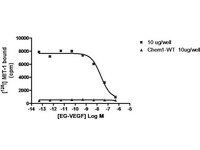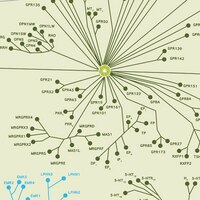Prokineticin 2 transmits the behavioural circadian rhythm of the suprachiasmatic nucleus.
Cheng, Michelle Y, et al.
Nature, 417: 405-10 (2002)
2002
Afficher le résumé
The suprachiasmatic nucleus (SCN) controls the circadian rhythm of physiological and behavioural processes in mammals. Here we show that prokineticin 2 (PK2), a cysteine-rich secreted protein, functions as an output molecule from the SCN circadian clock. PK2 messenger RNA is rhythmically expressed in the SCN, and the phase of PK2 rhythm is responsive to light entrainment. Molecular and genetic studies have revealed that PK2 is a gene that is controlled by a circadian clock (clock-controlled). Receptor for PK2 (PKR2) is abundantly expressed in major target nuclei of the SCN output pathway. Inhibition of nocturnal locomotor activity in rats by intracerebroventricular delivery of recombinant PK2 during subjective night, when the endogenous PK2 mRNA level is low, further supports the hypothesis that PK2 is an output molecule that transmits behavioural circadian rhythm. The high expression of PKR2 mRNA within the SCN and the positive feedback of PK2 on its own transcription through activation of PKR2 suggest that PK2 may also function locally within the SCN to synchronize output. | 12024206
 |
Endocrine gland-derived VEGF and the emerging hypothesis of organ-specific regulation of angiogenesis.
LeCouter, Jennifer, et al.
Nat. Med., 8: 913-7 (2002)
2002
Afficher le résumé
The diversity in growth and morphological characteristics among endothelial cells in different normal tissues and tumors has been long recognized. Yet there has been no clear molecular explanation for such diversity at the level of vascular endothelial growth factor A (VEGF-A) and other established regulators of angiogenesis that are expressed widely and show little tissue selectivity in their angiogenic properties. Endocrine gland-derived VEGF represents the first example of a tissue-specific angiogenic factor, likely to be followed by others. | 12205443
 |












